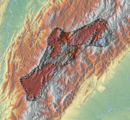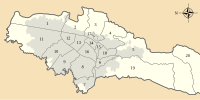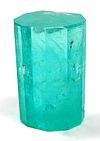Bogotá savanna
Template:Geobox The Bogotá savanna is a high plateau located in the center of Colombia in the Eastern Ranges of the Colombian Andes. It is the southern part of a larger plateau called Altiplano Cundiboyacense that rises to an average altitude of 2,600 metres (8,500 ft) above sea level.
This plateau is crossed from north to south by the Bogotá River, which at the southwestern edge of the plateau forms the Tequendama Falls (Salto del Tequendama). Other rivers, tributaries of the Bogotá river, form smaller valleys with very fertile soils dedicated to agriculture and cattle-breeding.
Etymology
The Bogotá savanna is named after Bogotá, which is derived from Chibcha and means "(Enclosure) outside of the farm fields".[1]
History
The earliest confirmed inhabitation of present-day Colombia was on the Bogotá savanna with sites El Abra, Tequendama and Tibitó, where semi-nomadic hunter-gatherers lived in caves and rock shelters. One of the first evidences of settlement in open area space was Aguazuque, whose oldest dated remains are analysed to be 5000 years old. This prehistorical preceramic period was followed by the Herrera Period, commonly defined from 800 BCE to 800 AD.
At the arrival of the Spanish conquistadors the region was inhabited by the Muisca who lived in hundreds of villages scattered across the plateau. These villages were individually ruled by caciques who at the same time paid tribute to the zipa, ruler of Bacatá. After the defeat of the Muisca rulers, Bogotá was founded and the Spanish colonizers engaged in the construction of Spanish-style towns to replace all the indigenous villages and in the process of assimilation and religious convert of the Muisca. The majority of those villages kept their indigenous names, but some were slightly modified in time, like Suacha which became Soacha, Hyntiba becoming Fontibón and Bacatá becoming Bogotá.
Timeline of inhabitation
| Timeline of inhabitation of the Bogotá savanna, Colombia | |
 |
   |
Cities

The main cities of the Bogotá savanna, in addition to the capital city of Bogotá, are: Mosquera, Soacha, Madrid, Funza, Facatativá, Subachoque, El Rosal, Tabio, Tenjo, Cota, Chía, Cajicá, Zipaquirá, Nemocón, Sopó, Tocancipá, Gachancipá, Sesquilé, Suesca, Chocontá and Guatavita.[2]
Climate
The average temperature of the plateau is 14 °C, but this can fluctuate between 0 °C and 24 °C. The dry and rainy seasons alternate frequently during the year. The dry months are December, January, February and March. During the rainy months the temperature tends to be more stable with variations between 9 °C and 20 °C. June, July and August are the months that present the largest variations of temperature, and during the morning frost is regular, which has a negative impact on agriculture. Hail or ice storms are also common.[3][4]
Hydrology


There is a system of swamps (humedales) that regulate the soil moisture acting like sponges for the rain waters. The most important wetlands are: La Conejera, El Burro, Jaboque, Santa María del Lago, Tibabuyes, Córdoba and Guaymaral.[5]
Rivers
Lakes
Natural
Artificial
- El Muña Reservoir
- San Rafael Reservoir
- Tominé Reservoir
- Lake Herrera (since 1973)[6]
Waterfalls
Panorama
See also
References
- ^ Template:Es Etymology Bacatá - Banco de la República
- ^ Cities on the Bogotá savanna
- ^ "Climate: Bogotá - Climate graph, Temperature graph, Climate table". Climate-Data.org. Retrieved 2016-09-29.
- ^ "Weatherbase: Historical Weather for Bogota, Colombia". Weatherbase. Retrieved 2016-09-29.
- ^ Template:Es Descripción General de los Humedales de Bogotá
- ^ Template:Es Lake Herrera largest water reserve of the Bogotá savanna




